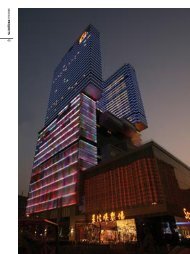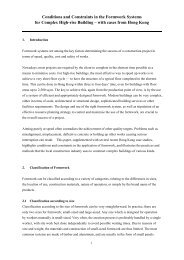Slope Works
Slope Works
Slope Works
- No tags were found...
Create successful ePaper yourself
Turn your PDF publications into a flip-book with our unique Google optimized e-Paper software.
<strong>Slope</strong> Protection
Classification of slopeNatural slope – in various conditions, includingrock slopeMan-made slope - including cut-back slope orslope formed by filled material with adequatecompaction, usually provided with surface andsurface drainageMan-made slope – formed mainly with the supportby retaining structures
Components on a well-design andmaintained man-made slope1. Surface protection such as vegetation (rigidcover (masonry, plaster or shotcrete)2. Surface drainage (including surface channels,catch pits and sand traps)3. Subsurface drainage (including weepholes andsubsoil drain etc.)4. Other protective provision such as prestressedground anchorsNote – try to avoid the placing of water-carryingservices onto a slope
How a slope fail?The most common failures in slopes of Hong Kongare come from the relatively shallow top soil,which further worsened by the depth of weatheringand infiltration during rainstorms situations.<strong>Slope</strong> can collapse easily by shear if the soil is nearlysaturated and high pore pressure can be built uprapidly. The falling debris carried by its potentialand momentum can rush down the slope at veryhigh speed and travel a long distance causing hugedamages.Besides, highly decomposed rock in a slope maybehave very similar to soil.
Typical failureprofile for slope
Factors affecting the stability of slope1. Topography and its surrounding physical conditions.Detail analysis can be done by appropriate siteinvestigation process.2. Geological conditions such as the nature and depthof its subsoil, degree of decomposition, or locationof fracture etc. This data can be obtained by soilinvestigation.3. Shear strength of the slope-forming materials. Datacan be obtained using appropriate laboratory tests.4. Surface and ground water condition5. External loading and surcharges, such as fromtraffic, nearby structures, possible vibration etc.
Physical environment and Typographical conditions of a very large site(Tseung Kwan O site formation)
Another example of large scale slope work as part of the site formation forthe Tsing Yi North Coastal Road
Stability of slope can be effectively improved by theprovision of an appropriately design drainage system,this cab be achieved by:1. A surface drain system that is capable to discharge all the stormwater within the rain water catchment area affecting the slope ina designated period of time (say, 200mm rainfall/hour).A surface drain system usually consists of:- surface channel- stepped or trapezoidal channel- catchpit or sand trap2. A subsoil drain system that is laid below surface for thedischarging of ground water and to maintain the water pressurebe kept in a safe level- filter layer behind the slope leading water to outlets- weepholes - cut-off drain- subsoil drain pipe
Forming surface drainage channel to slope
Protection and treatment to Rock <strong>Slope</strong>Most rock slopes need some forms of treatment toensure continued stability. Improvement methodsinclude:1. Scaling – loose blocks or boulders to be removedfrom exposed rock surfaces, this is usually done bymanual method.2. Construct buttress support – this is concrete ormasonry gravity structure use to retain the unstablerock mass3. Dentition – exposed soft material in a rock face betrimmed back. The resulting slot be filled with filtermaterial and protected by masonry or concrete toprevent erosion.
Protection and treatment to Rock <strong>Slope</strong> (continue)4. Sprayed concrete – apply concrete protection to zonesof weak or highly fractured rock faces by spray-onmethod.5. Dowel – a hole is drilled and provide untensionedsteel bars, usually 25mm to 35mm dia. and 1m to 3mlong, to stabilize a weak rock zone. The hole would begrouted afterward.6. Rock bolt/nail – this is tensioned bar inserted into rockforming a short anchorage zone in rock so that anunstable slope area being reinforced by tension.Typical rock bolts are 25mm to 40mm in dia. 3m to6m long, and have a tensile workign load around100kN.
Forming a steep slope inset-back benches and inphases starting from thetop downward. Note thatthe upper benches arestrengthened by soil nailsScaling a rockslope surface
Various methodsto stabilize a rockslope
Improvement the slope profile by forming benches
Protecting a slope by the use of buttress wall
Forming soil nail and rock bolts
Protection and treatment to Earth-filled slopeWhere a slope is to be stabilized to eliminate possibleflow-slide, the surface layers should be stripped to avertical depth not less than 3m and replaced it withdry and well compacted fill.A drainage system is also required between old andre-compacted fill to prevent development of waterpressure behind the filled zone.If it is possible, try to reform the profile of the slope toa safe angle which is determined by mathematicanalysis.
Protection to slope by rigid surfaceRigid surface protection on slopes are commonly used to reducerainwater infiltration and to prevent erosion of the slopeformingmaterials. This can be done by:Chunam plastering – this is an applied-on surface protection toslope using a clay and cement mixed plaster. Thickness ofthe plaster is around 40mm to 50mm for permanent works.Sprayed concrete (shotcrete) – protection by applying a sprayingmortar onto surface of slope.Masonry or stone pitching – lay stone rubble or block (with filterlayer underneath) onto surface to protect slope fromweatheringIn general, rigid surface may create a very awkward appearance.Besides, the surface is highly impermeable thus weep holesare required for draining out of the ground water to avoid thedevelopment of high water pressure behind the slope
Preparing the surfaceof slope duringmaintenance process
Forming a slope by scaling,cutting back into benches,and protect surface by rocknail and shotcrete
Improvement to slope by soft surfaceAfter the preliminary protection treatment, slope can befurther improved by some softer means, such as:1. Hydroseeding – is the application of grass seed mixedwith fertiliser and Nutriant in aqueous solution byspraying method. The grass seed will grow eventuallyand the root of the grass will act as an organicreinforcing fiber and hold the surface soil.2. Turfing – Turfing is the direct application of grass withdeveloped roots onto the slope surface. The relativelymatured grass will grow easier and extend its root intothe soil to strengthen the overall surface.3. Planting of tree – usually done at the same time with theother method to provide better visual result and providefurther strengthening effect to the slope by its deep root.
Various methodto treat a slopesurface usingvegetation
Nylon mesh for sub-surface drainageand to reinforce the root of grasspTurfing a slope surface
Stage of greening anewly treated slope1 st month2 nd month
Stage of greening anewly treated slope3 rd month4 th month
Seeing the difference betweena slope treated with andwithout landscaping provision
Protect a slope by the use of retaining wallRetaining wall are structures usually provided at the toe ofa slope to stabilize it from slide, overturn or collapse.A slope will be relatively stable when its profile (sectionangle) is kept below its angle of repose.Angle of repose is an angle that maintains naturally to asafe equilibrium by the composing material of a slope.This angle deviates from differing materials dependingon their compaction, particle size and the nature of thematerial itself. (e.g. cohesiveness and shear strength)Principle to retaining wall design can be of 2 main types- cantilever type- Gravity type- Earth reinforced type
Various formsRC cantilevertype retainingwall structures
Common failure modes ofa retaining wall
Construction oftypical gravity typeretaining wall and itsdrainage arrangement
Construction oftypical cantilever typeretaining wall and itsdrainage arrangement
Stone mass at the toe of abench serves to provide agravity hold for theretaining soil-filled slopeUsing stone pitching asa rigid slope surface
Construction of RC cantilever/gravitymixed type retaining wallButtress of wallFooting of wall
Construction of Earthreinforcedretaining wallButtress of wall
Construction of Earth-reinforced retaining wall, with a temporary sheet-pile wallas stage one set-back arrangementButtress of wall
Detail of the precast panel assurface panel of the retaining wall
Detail seeing the tie behind thepanel of the earth reinforced wall
External view of some of thepartially completed earthreinforced retaining wall
Other example of using earthreinforced wall to obtain extraspace for a road widening project
Examples where large-scale slope works arerequired in construction1. Building work – obtaining of land space forbuilding developemnt by land/site formation2. Roadwork – road or highway project includingnew projects, extension, widening orimprovement works3. Emergency/Major repair of slope,e.g. after serious land slide
Example of slope works forBuilding related project
Site formation to obtain a terraced land for the placing of a building- producing a retaining structure to support an adjacent structure
Sequence showing the forming of amulti-construction retaining wallusing bore-pile and soldier-pile wallwith in-situ concrete facing wall
Sequence showing the forming of a multi-construction retaining wall using bore-pileand soldier-pile wall with in-situ concrete facing wall
Diaphragm wall panel tieback using ground anchorForming of a temporary vertical cut as partof the site formation work to acquire land forbuilding construction project – Festival Walk
Site formation producing a temporary slope as part of a buildingconstruction component – CityU Academic Exchange Centre
Site formation producing a temporary slope as part of a buildingconstruction component – South China Sport Association Extension
Site formation producing a temporary slope as part of a buildingconstruction component – South China Sport Association Extension
Setting-back and stabilizingof a natural slope usingbuttress wall for a residentialdevelopment project inRepulse Bay, Hong Kong
Example of slope works forCivil Engineering related project
<strong>Slope</strong> stabilization to form a newcoastal roadway near CyberportButtress of wall
Buttress of wall
<strong>Slope</strong> setting back to give wayfor the passing of an elevatedroadway for Route 8 nearButterfly ValleyButtress of wall
Stabilization of a vertical faceas strengthening provision fora new roadwayButtress of wall
Forming a widened roadway along a strip of virgin land under Tai Po Roadinvolving slope treatment/stabilization on both side of a valley
Cutting of large volume of slope to give way for thepassing of a series of carriageway in Tai Wai, ShatinOriginal profile ofslope being cutButtress of wallFooting of wall
Cutting into a surcharged slope to accommodate a series of column to support anelevated roadway (slope stabilized with sheet-pile wall tied back with anchor)Buttress of wall
Drilling machine toform the bore-holefor the anchor tendonInstalling the soil anchor and tighten theskin wall with a row of waling beam
Cutting back of slope using bore-pile wall
Cutting back of slopeusing soldier pile wall
Cutting back of slope using in-situ RC retaining wall in plant-box design
Detail of the steppedplanter-box type retaining wallPrecast units forretaining wall facingpanel with a surfacedrain channel
Construction wall
Preliminary treated slope with geo-textile and surface greening
Natural terrainMain CarriagewayReinforced fill embankment
Widening of roadway by obtaining land cut to the edge of a building
Widening of roadway by obtaining land cut to the edge of a building
Stage 1 cutting back of slopestabilized by ground anchors.Stage 2 permanent wallsupported by using bored-piles.
Widening of existingroadway by cuttingand afterward filling
Widening of existing roadwayby cutting, temporarystabilizing and afterward filling
Widening of existing roadwayby cutting, temporarystabilizing and afterward filling
Stabilizing large area of slope along a servicing roadwayTai Po Road to ShatinFuture alignment of a new trunk road (Route 8)
Widening of Castle PeakRoad near Sham TsengOther examples of slopetreatment or stabilization ofmore complex in nature
Other examples of slope treatmentor stabilization of more complexin nature –problem and method tocollect and discharge storm waterdue to very large catchment area
Other examples of slope work or stabilization provision of more complex innature – complicated topographic condition and work layoutWidening of Castle PeakRoad near Sham Tseng
Maintenance of slopeConditions of a slope can be easily deteriorated within acertain period of time thus continual observation andmaintenance should be carried out from time to time.In Hong Kong, the responsibility of slope maintenance are:• For lands belong to the government – by the government,responsible/managed by the Civil EngineeringDepartment.• For private lands – owner of the land. Very often theexact responsibility for the maintenance of a slope isspecified in some legal documents such as in the landlease. Detail information for the lease documents andrecords of the land owners can be obtained at theGovernment’s Land Registry.
Maintenance Inspection (including slope andretaining walls)Inspection should be carried out regularly to determinethe conditions of a slope. These inspections can besub-divided into 3 levels/categories.1. Routine inspection – by non-professional personbases on some general visual guideline.2. Engineer inspection – by qualified geotechnicalengineer according to some engineering indicationsand standards3. Regular monitoring process – by a qualityengineering firm with special expertise and mayinvolve the use of some monitoring devices oranalysis
Routine Maintenance InspectionAs a preliminary inspection to ensure the basic stability of aslope, routine inspection is recommended to carry out ona regular basis. The following elements should beobserved during the inspection:1. Ensure the slope surface and its drainage channels arefree from debris.2. Damaged or cracked protective surfaces and drainagesystem should be repaired and keep in good condition.3. Unblock the weep holes and drains from time to time.4. Remove over-grown vegetation that may crack thesurface.5. Observe any damage appears on the slope or otherretaining structures6. Observe any irregularity appears on or nearby the slope
Common condition of a slope
Typical man-made items on slope and retaining wall that require maintenance
Cut-off drainTypical preventive maintenance works for soil slope
Typical preventivemaintenance worksfor rock slope
Typical Routine Maintenance <strong>Works</strong> for slopes and retaining walls
















